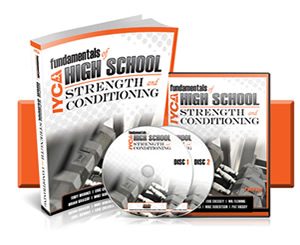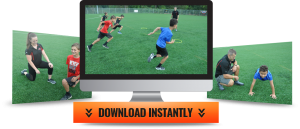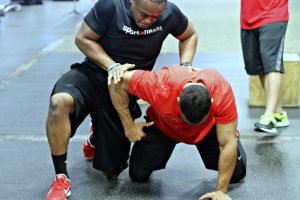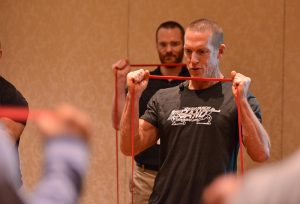Training Young Athletes Using Olympic Lift Alternatives

As a coach and professional I know that I love the Olympic lifts when training young athletes. For good or bad I think that there is no EQUAL to getting athletes more explosive than the Olympic lifts.
Being married to a lift or movement places too many limitations on the program you are able to design and in particular limits the improvements that each individual athlete can make.
For the athletes that are exclusively training with me and are physically capable the Olympic lifts are the king of my gym. There is no BETTER way to get explosive.
As my training business has grown, however, more and more athletes find out and are recruited to train with me, the necessity is not to place my training on them, but to discover the best training methods for them.
This means that the athlete that are concurrently training in their high school and doing Olympic lifts 2-3 times a week need alternative methods to train explosively with me. My beliefs are not something that can supersede the needs, time or ability of the athlete.
This being the case when we are training young athletes, the Olympic lifts have been replaced with alternatives that replicate the explosive nature of these lifts.
Using Medicine Balls To Train Young Athletes
The broad category of medicine ball throws can be used for nearly every athlete to produce explosive strength. These throws provide a low impact to the athlete but a maximal force production.
Throws in the rotational plane can be used to develop a vital linkage of the upper body to the lower body through the core musculature. Correctly performed throws originate in the lower body and leave through the hands, a kink in the core armor will be very apparent if a delay occurs from initiation to delivery.
Regardless of whether athletes can do Olympic lifts or not, medicine ball throws are a vital part of athletic programs, nothing develops the all important power in the transverse plane quite like rotational medicine ball throws.
KB Swings To Train Young Athletes
Much has been written on the kettlebell and benefits of using it to develop explosive strength. The addition of elastic resistance can take this movement to an entirely different level.
The swing itself is an excellent tool to develop an explosive hip hinge pattern. Most athletes lack in the ability to feel the explosive hinge and the swing is the best movement that I have found to break knee dominant athletes of using the knee bend to initiate explosive motion in the lower body.
The end range of hip extension is one of the best ways for athletes to truly feel the maximum contraction of the glutes. The voluntary muscle contraction that most athletes have difficulty attaining through other movements is a must for athletes to achieve a total hip extension.
The addition of elastic resistance allows accomplishes 2 main objectives:
1) It spares you of having to buy an unlimited number of kettlebells. Our biggest kettlebell is 32 kg. Many of our high school athletes can toy around with this weight with little to no difficulty for 10-15 swings. By adding even a small band to the kettlebell, 10-15 swings becomes a much greater challenge.
2) The majority of resistance occurs at the top end, where athletic movements occur. The maximal contraction should occur at the top end of the swing movement. With just the dead weight resistance supplied by the kettlebell athletes are sometimes apt to use the top extension as a point of relaxation. The addition of band resistance increases the load as it travels away from the floor. This top “high resistance” position is also the position in which most athletic movements occur.
In general swings simulate overall athletic movement. A correct swing should have the athlete relax momentarily at the top of the swing after reaching full hip extension but before returning to contraction at the top. This contract, relax, contract pattern allows for greater recruitment on the next upward swing.
Prowler Sprints To Train Young Athletes
The goals of Olympic lifting are varied. They can go from becoming a better competitor, across the spectrum to improving speed (I first noticed that I had become a much more powerful athlete due to Olympic lifting when my 40 yard dash time dropped .5 seconds in just 6 months) For the latter a great substitution is to do resisted sprinting with the prowler.
The idea of special strength training was popularized by USSR coaches, and in particular those coaches in track and field. My first exposures to it were as a hammer thrower, to us special strength training was literally training the specific event in which I competed with a heavier implement (can’t get much more special than that!). Prowler sprints are the perfect special strength tool for athletes looking to improve acceleration.
The sets are typically 8 seconds or less, and the athlete gets adequate rest. This timing both mimics the boughts typically seen in athletic competition, the length of time for typical Olympic lifts, and helps increase the alactic power an athlete is able to produce.
An increase in stride length will be seen for athletes training with resisted sprinting techniques. This increased stride length will be due to an increase in the athletes’ ability to produce more power.
Submaximal Front Squats or Deadlifts to Train Young Athletes
This is something that I have been toying with recently that has really improved the maximum power output that we are seeing from our athletes.
Loads of 40-50% 1RM on the bar and band resistance of less than 100lbs should be used. Athletes should be instructed to lift the weight with maximal force on the concentric portion of the movement.
Recently Bret Contreras wrote an excellent article on similar movements In it he describes recent research showing that maximal force produced during 40% of 1RM in the Hex Bar Deadlift is surprisingly similar to that produced in the Olympic lifts. (4800 Watts Hex Bar vs. ~4900 Watts in O lifts). While research has shown that maximal power production measured in watts can be achieved in the split jerk at nearly 6000 watts, this is very close when it comes to the big 2 Olympic lifts (snatch/clean).
Adding bands to the puzzle has not yet been studied but anecdotally my athletes have seen a large improvement in the ability to produce power top end hip extension. The greatest load is encountered at this point in which the athlete has the greatest mechanical advantage.
The bands pull the athlete down at a faster rate in the eccentric phase of the lift. To resist this greater speed the posterior chain must contract with a greater force. This is similar to the eccentric portion of plyometric action. Higher rate of contraction in the muscle spindles will lead to a greater force of contraction on the concentric portion of the lift.
Check these moves out next time your training young athletes and let me know what you think.
Learn how to become a Certfied High School Strength and Conditioning Coach by Clicking Here.

 Jordan Tingman – CSCS*, USAW L1, ACE CPT, CFL1 is a graduate of Washington State University with a B.S. in Sports Science with a Minor in Strength and Conditioning. She completed internships with the strength & conditioning programs at both Washington State University and Ohio State University, a Graduate Assistant S & C Coach at Eastern Washington University, and is currently training athletes of all ages near her home in Seattle, WA.
Jordan Tingman – CSCS*, USAW L1, ACE CPT, CFL1 is a graduate of Washington State University with a B.S. in Sports Science with a Minor in Strength and Conditioning. She completed internships with the strength & conditioning programs at both Washington State University and Ohio State University, a Graduate Assistant S & C Coach at Eastern Washington University, and is currently training athletes of all ages near her home in Seattle, WA.



 sport dominance. After school the weight room is often dominated by off-season football or power-lifting making it difficult for female sports to access and in most cases weight room size does not allow both programs to train simultaneously.
sport dominance. After school the weight room is often dominated by off-season football or power-lifting making it difficult for female sports to access and in most cases weight room size does not allow both programs to train simultaneously. About the Author: Dave “The Band Man™” Schmitz, has been writing, teaching and training how to implement strength training with resistance bands for rehabilitation, fitness and performance since 1996. In 2008 Dave founded Resistance Band Training Systems, LLC and with that launched
About the Author: Dave “The Band Man™” Schmitz, has been writing, teaching and training how to implement strength training with resistance bands for rehabilitation, fitness and performance since 1996. In 2008 Dave founded Resistance Band Training Systems, LLC and with that launched  About the Author: Dave “The Band Man™” Schmitz, has been writing, teaching and training how to implement resistance band training for rehabilitation, fitness and performance since 1996. In 2008 Dave founded Resistance Band Training Systems, LLC and with that launched
About the Author: Dave “The Band Man™” Schmitz, has been writing, teaching and training how to implement resistance band training for rehabilitation, fitness and performance since 1996. In 2008 Dave founded Resistance Band Training Systems, LLC and with that launched 

 Julie is the Executive Director of the International Youth Conditioning Association (IYCA). She grew up as an athlete and played collegiate softball at Juniata College. She currently owns and operates her own youth fitness business pouring into young athletes. Her areas of expertise are youth sport performance, youth fitness business and softball training/instruction. Julie grew up on a dairy farm and can challenge the best of the best in a cow-milking contest. 😉
Julie is the Executive Director of the International Youth Conditioning Association (IYCA). She grew up as an athlete and played collegiate softball at Juniata College. She currently owns and operates her own youth fitness business pouring into young athletes. Her areas of expertise are youth sport performance, youth fitness business and softball training/instruction. Julie grew up on a dairy farm and can challenge the best of the best in a cow-milking contest. 😉

 Seriously, they can go anywhere! Resistance bands don’t take up a ton of space, and they aren’t heavy or hard to transport. Stick them in your trunk and use them in every session! (They are 100% TSA approved so you can even fly with them.) 😉
Seriously, they can go anywhere! Resistance bands don’t take up a ton of space, and they aren’t heavy or hard to transport. Stick them in your trunk and use them in every session! (They are 100% TSA approved so you can even fly with them.) 😉










